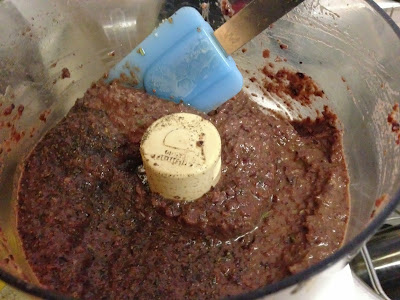So. I’m back.
I was talking with someone about this blog this summer, and
she spoke the fateful words “Yes, but now you have to keep it going.” Argh.
‘Twas a curse. The day job got busy, the dog ate my homework, etc. Sorry.
Here’s a quick snack-y dip-like thing that I’ve been making for a couple of decades now. It’s called tapenade, and it’s basically a salt lick for humans. You basically take a bunch of good olives and salty Mediterranean condiments and rip them to shreds in a food processor. Not much to it, really, but you can spread the results on bread or crackers, or use it as a dip for carrots, celery and the like.
I don’t have an original recipe on this one—there must have
been one, all those years ago, but I’ve no idea where I first encountered it. I
pretty much eyeball the measurements on this one, too, but I’ll try to give you
a rough sense of what’s going on. The truth is that the exact proportions are
not important here—all of this is to taste, really, although if you don’t like
olives, garlic, or salty foods, you’d probably be better off cooking something
else.
As for equipment, a food processor is pretty much de rigeur on this one, although you
could probably use a blender if you did everything in batches. Of course, if
you wanted to do the whole masochistic-locavore thing, you could mince
everything by hand. Or use a mortar and pestle. Food purists seem to love the
mortar and pestle, but I’ve never really understood why. It’s not as though
cooks from earlier times enjoyed pounding things for hours, and the finished
product isn’t any different (Alice Waters and I disagree on this). So I use a
processor, but if you want to embrace your inner cave person, by all means feel
free to pound everything with a rock instead. Hulk smash, and all that.
Olives are the main focus here. I’m using kalamata
(sometimes spelled calamata), which is a dark purple Greek olive. I like them
because they have good flavor. I also like them because you can usually buy
kalamatas already pitted. But you can use whatever olives you like—green,
black, Greek, Italian, French, or a mixture. I usually raid the antipasto bar
at my supermarket for mine, but they’re available in jars as well.
I’m still not very good on taking these ingredient shots.
Other blogs post gorgeous photos of all the ingredients in a recipe. I assemble
a few, take the pictures, and then realize that I forgot half of them. Anyway,
you need a cup to a cup and a half of whatever olives you’ve chosen. Hopefully
you bought pitted ones, but if not, pit them before you go any further.
You’re going to need 3-4 peeled garlic cloves. Don’t be
timid about the flavorings, btw. Tapenade is supposed to be boldly
flavored—that’s the point. I usually turn on the processor, and drop in the
garlic through the feed tube. It will be chopped instantly.
After that, it’s really just a matter of adding the other
ingredients: the olives, 5 or 6 anchovy fillets, a dollop (maybe a teaspoon?)
of Dijon mustard, a tablespoon or so of capers, freshly ground black pepper,
and some herbs. I had a little bit of fresh rosemary in house, so that went in.
Thyme is good, as is (are?) herbes de provence, should you happen to have some
on hand.
Purée this mixture, and then add the juice of half a lemon.
Now fire up the machine again, and while it’s running,
drizzle in a glug (1/4 – 1/3 cup) or so of olive oil. You are done. If you wanted something
more substantial, you can also blend in a can of tuna that you have drained
well.
And that’s it. It’s best to chill it before you serve it. Good
on crackers, bread, or anything else that strikes your fancy. Bon appetìt, y’all.






Grant, perfect for a rainy evening with a nice bold glass of red. Welcome back!
ReplyDeletejans